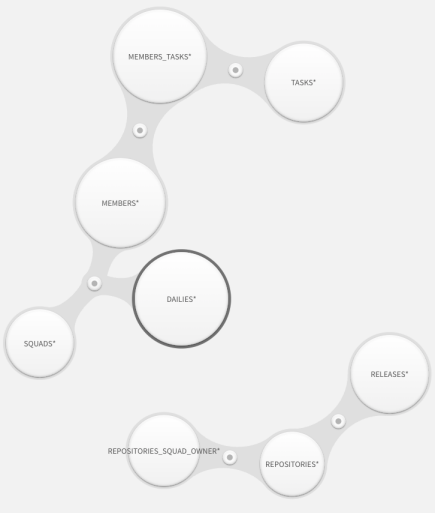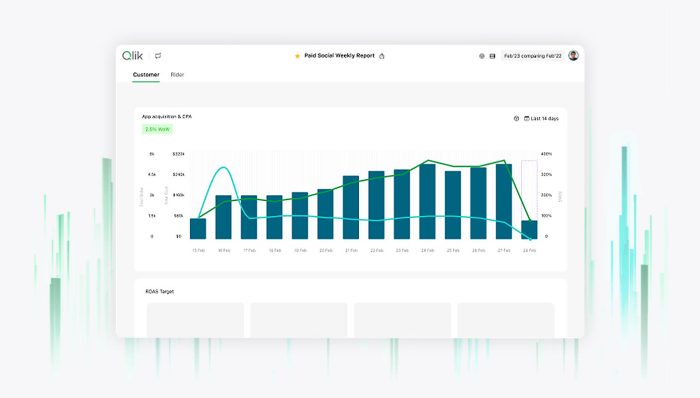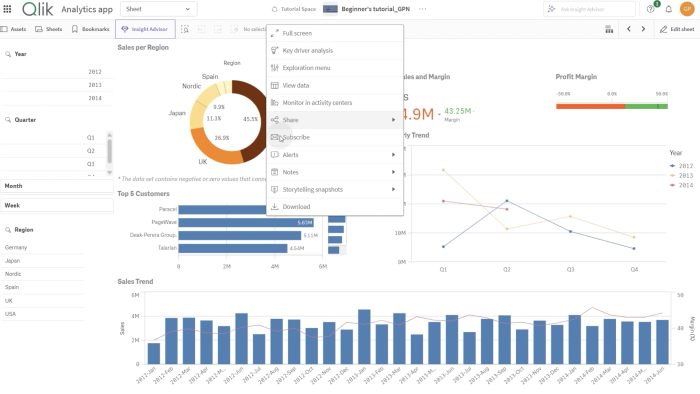Welcome to the latest Qlik update! This video showcases new capabilities designed to help you work smarter with your data. Discover improvements in sheet editing, visualizations, automations, reporting, and API-driven workflows. Whether you’re a developer, analyst, or admin, these updates make Qlik even more powerful and easier to use.
New: Qlik Analytics Migration Tool (QAMT)
Qlik has released the Qlik Analytics Migration Tool (QAMT) to support faster, easier migration from QlikView, Qlik Sense, and NPrinting to Qlik Cloud. Built on technology acquired from Stretch Qonnect (press release), QAMT automates the discovery, transformation, and migration of analytics assets—reducing the effort, cost, and complexity of cloud adoption.
QAMT is integrated with Qlik Cloud APIs and offers structured workflows for both self-service users and partners. The tool is available at no cost to Qlik customers and certified partners.
If you don’t yet have a Qlik Cloud tenant, you can request a complimentary one through your Qlik representative.
Contact us to get started.
New app settings design
App settings has been refurbished and gets a new home with tabs for easy navigation between the categories of settings.
Class balancing during experiment training
ML experiments in intelligent model optimization mode will review the balance between classes and, where there is imbalance, apply oversampling to establish more accurate model training.
Intelligent model optimization
Reload-time variable updates and variable constraints
To support dynamic reload workloads, reload-time variable updates and variable constraints have been added for Analytics apps.
Using the new variables property on the Reloads API, you can set variables directly in a reload request, enabling dynamic app behavior without editing the load script. This reduces complexity, improves deployment automation, and brings parity with QlikView-style task-driven customization.
To prevent accidental or unauthorized overrides, you can now constrain variables in the load script. This ensures that certain variables must meet specified criteria even when passed dynamically. This protects your app from malicious or malformed variable input that might break app logic or SQL queries, and unintended overrides in templated apps.
Reload-time variable updates can be used alone to streamline deployments. Constraints can be used independently to validate variable values.
Together, they form a secure and flexible configuration model for large-scale, multi-tenant, or dynamic deployments.
For more information about reload-time variable updates, see the changelog entry on the Qlik Cloud Developer Portal.
To learn about setting constraints, see the Constrain reference on help.qlik.com and the GenericVariableConstraints schema.
HTML reports for the inbox!
Create custom analytic reports for email review with HTML reports. Now report developers can use an HTML editor (within an app) to author report templates that can be used as the email body of report tasks. HTML format reports can also be attached to emails or moved to a file store.
Designing HTML report templates
PixelPerfect template editor improvements
Following on the release of our first in-app PixelPerfect report template editor, report developers will find some improvements in the template editing experience:
Getting started with PixelPerfect report templates
Adding images to a PixelPerfect report template
New Straight table becomes default
The new straight table in the bundle is graduating and taking place in the chart section and becoming the default table. The old table will still be around but marked as retired in the asset panel. We recommend everyone to upgrade to the new table and enjoy all the new features. Over time the old table be deprecated, announced well in advance.
Security enhancements for Qlik Sense Mobile SaaS
The Qlik Sense Mobile SaaS mobile client now incorporates additional defense-in-depth security features that help ensure mobile devices meet various compliance standards. If the operating environment is found to deviate from these standards, access may be restricted and an alert issued. Please ensure that your organization’s mobile OS and network configurations are maintained in line with industry best security practices.
Folder support for storage of prediction and experiment datasets
When defining a prediction dataset filename in an ML deployment, you can include a folder path to organise prediction datasets. This also includes using dynamic naming as part of the path.
Folder path storage is also now supported when exporting datasets from the Compare and Analyze tabs in an ML experiment.
Dynamic naming and storage for batch predictions
Pivot table indicators
The new pivot table in the bundle is getting indicators. Add icons and colors based on thresholds, quick and easy on any measure.
Pivot table (Visualization bundle)
Updated editing experience
The sheet editing experience has been updated, replacing the standard edit mode with new edit mode that combines the former advanced edit mode with the new filters and data preview from standard edit mode.
New Direct Access gateway version (1.7.5)
Direct Access gateway 1.7.5 introduces support for overriding the default Windows service account during setup, and resolves several issues. For upgrade instructions and a list of resolved issues, see Upgrading the Direct Access gateway installation.
Introducing Knowledge Marts
Qlik Talend Cloud is introducing knowledge mart tasks to automate the transformation, vectorization and loading of data into a vector store to support custom semantic search and retrieval-augmented-generative (RAG) AI applications.
Two new tasks have been introduced with this release:
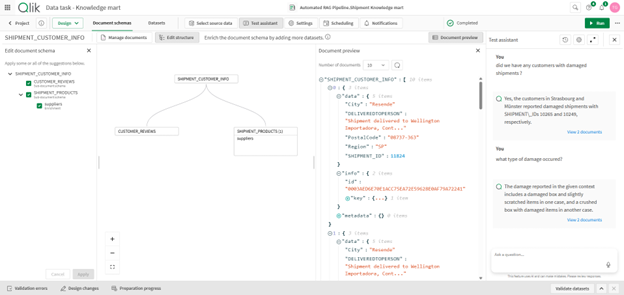
The Test Assistant supports testing vector store content via natural language semantic search for both styles of Knowledge Marts.
Knowledge Mart and File-based Knowledge Mart tasks support:
Code auto-completion and auto-formatting for increased developer productivity
Qlik Talend Cloud Pipelines introduces code completion and formatting capabilities to make it easier to write SQL transformations. SQL auto-complete suggests table and column names, as well as SQL keywords as you type.
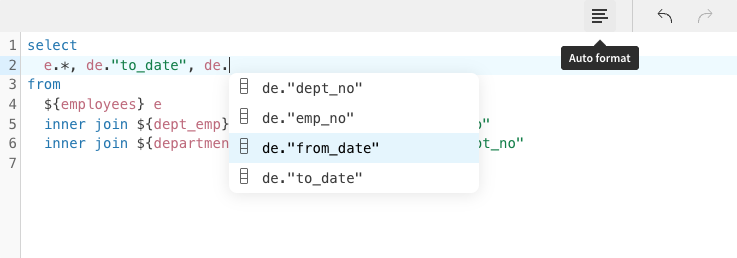
This improved SQL editing experience is available for all customers – just start typing!
Catalog filter change: Data to Datasets
The filter menu of the Catalog will now refer to Datasets rather than Data to be clearer about the content type the filter is retrieving.
Browsing datasets from the Catalog
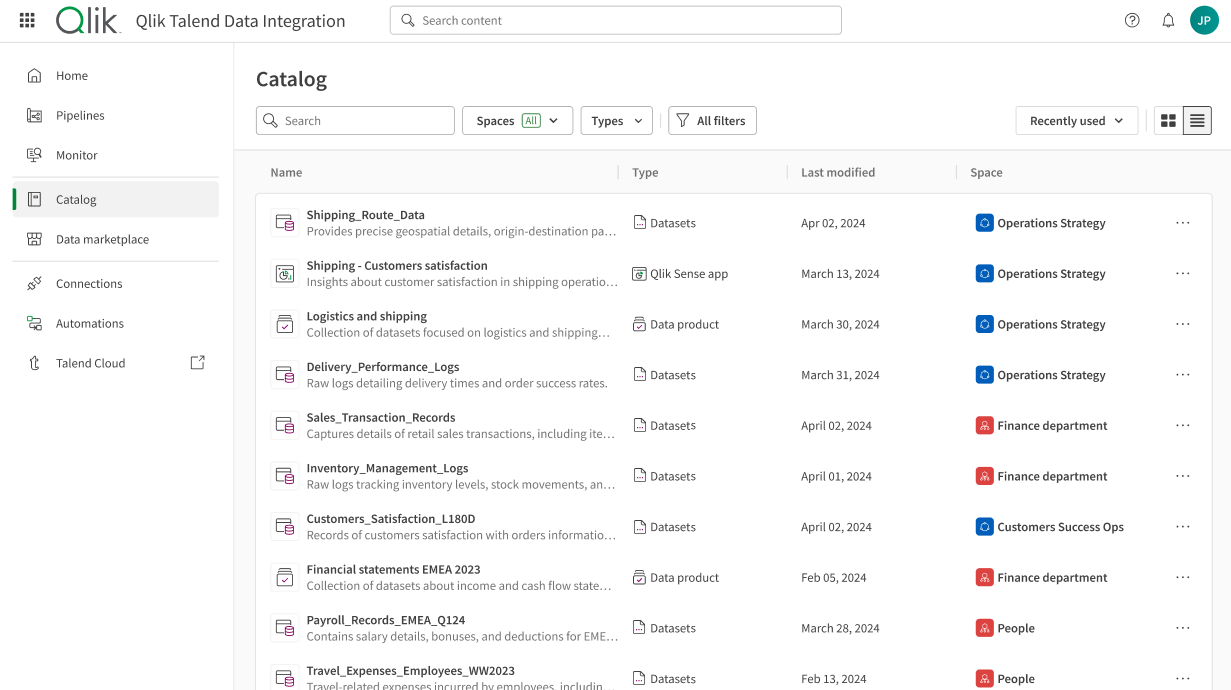
You need a Qlik Talend Cloud Enterprise subscription.
Using filters, you will be able to browse and look for trusted datasets to use in data products. Datasets can be the result of a manual upload, or created from a data project when using the Publish to catalog option. For more information on publishing to Catalog, see Data pipeline project settings.
Data products retain model when opened in Qlik Sense
When users create a Qlik Sense app from a data product, the data model from the Qlik Talend Cloud task are transmitted to the Qlik Sense app itself, so that users do not have to recreate the data model in the Sense. This model can be viewed from Data model viewer in Qlik Sense.
What is not included:
Data product documentation for viewing or download
Until now, to view the documentation of a data product, one must click through multiple datasets within the data product and multiple tabs to see quality, profile, data product, dataset, and field descriptions, lineage, consumption details, etc.
Now you can view a single, comprehensive, Wikipedia style document about the data product. This can be viewed directly within the Data Marketplace or exported as a PDF making review of the information easier for consumers.
Generating the documentation of a data product
Leverage Qlik Talend Cloud rules in Talend Studio
Talend Studio users can now leverage validation rules and semantic types defined in Qlik Talend Cloud directly within Talend Studio. A new component allows seamless use of centralized rules, ensuring consistency, reusability and better productivity.
Key benefits:
New import format and user interface in Qlik Talend Cloud Pipelines
As of today, when importing projects via the user interface using a zip file, users now get access to a new user interface. This enables making selections for project settings such as:
The export file format has been changed from a single JSON file to a ZIP file containing several JSON files. The old JSON format will be supported for import until January 30, 2026. To convert your JSON files to the new format you can import them, and then export them to the new ZIP format. Projects in the old JSON format cannot be imported via the API.
Users are advised to export their existing projects to enjoy the new format by January 30, 2026.
Exporting and importing data pipelines
Exporting and importing replication projects
Dedicated menu entry for data product management
Data product management is now accessible from its own dedicated menu entry, separate from the Data marketplace. This paves the way for future enhancements of the data product manager experience, while improving clarity and usability for data products managers.
Secured access to data sources using SSH tunnel
Customer that are not using Data Movement gateway can now connect to supported data sources via an SSH tunnel. Tunneling allows you to securely access data sources located behind a firewall while also encrypting all data passing through the tunnel.
Supported data source connectors:
Qlik Trust Score™ for AI
The latest Qlik Cloud update introduces new dimensions to the Qlik Trust Score™ to enhance how organizations evaluate the readiness and reliability of datasets for artificial intelligence applications. These additions provide deeper insight into data quality. It helps securing trustable AI outcomes and reduce the risk of bias.
Key features
Qlik Trust Score™ historization
Uncover quality trends and gain actionable insights through historical Qlik Trust Score™ data. Monitor quality over time and understand the specific events that impact the Qlik Trust Score dimensions, enabling proactive governance and continuous improvement.
Key features
……. … ………… ….
Any questions please contact our consultants. Responding in one working day.
